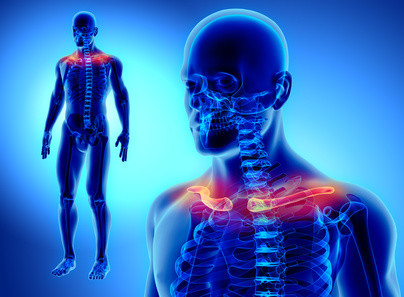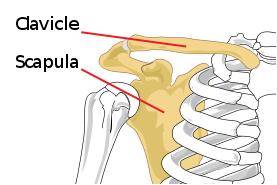Swollen Clavicle (Collarbone Swelling) Causes and Symptoms
The human clavicle, also known as the collarbone, is a short bone that connects the upper limbs (arms) to the trunk. It can be easily felt under the skin lying above the first rib and in thin people it can also be clearly seen. The clavicle is a strong and resilient bone that has to bear the weight of the upper limb and remains firm in its position to provide stability to the ligaments and muscles attached to it. It has two important joints – the acromioclavicular (AC) joint where it meets the shoulder blade (scapula) and the sternoclavicular (SC) joint where it meets with the breastbone (sternum).
What is a swollen clavicle?
A swollen clavicle is any fluid accumulation or enlargement in and around the collarbone. In some cases the swelling does not involve the collarbone itself. The most common cause is soft tissue injury which commonly affects the muscles and subcutaneous tissue thereby causing swelling over the clavicle.
It may involve any of the muscles that attach to the clavicle as well as the platysma muscle which lies above and over the top of the clavicle. Swelling of the clavicle itself is referred to as a bony swelling. It may arise with injury to the bone and is more prominent with a fracture.
Symptoms of a Swollen Clavicle
A swollen clavicle is a symptom and not a disease. It may be accompanied by various other symptoms including :
- Pain – collarbone pain, sometimes also described as shoulder pain.
- Tenderness
- Difficulty moving the arm or shoulder
- Redness of the skin
- Heat of the area
- Pain, numbness or tingling of the arm
The symptoms may vary and depend on the cause of clavicle swelling.
Causes of swollen clavicle
It is important to first differentiate between soft tissue swelling around the clavicle and swelling of the bone itself. Swelling occurs due to inflammation which is the mechanism to protect tissue that is undergoing any injury or damage. The blood vessels allow fluid to seep out into the tissue spaces which then accumulates and causes edema (swelling).

Injury
Trauma is the most common cause of a swollen clavicle. It may occur with or without a fracture. Some of the causes of injury to the clavicle includes :
- Car accidents, even minor collision as the force when the seatbelt restrains the body may injure the chest and particularly the clavicle.
- Blows, related to falls, assault and other such injuries.
- Surgery.
- Sporting injuries.
Being a bone, the clavicle is hard and fairly resistant stress and injury. Minor injury may cause soft tissue swelling arising from the tissue just underneath the skin (subcutaneous tissue), the muscles like the platysma muscle, tendons of the muscles that attach to the clavicle, connective tissue or ligaments. Major injuries may possibly cause a fracture of the clavicle.
Infections
An infection of the clavicle rarely occurs on its own without other bones or surrounding tissue also being involved. It is more likely to be due to bacteria which may reach the bone through one of the followings routes :
- Direct entry of microbes into into the soft tissue or bone through a break in the skin (laceration) or deep piercing injuries.
- Spread into the internal soft tissue of the bone through the bloodstream from a distant site.
- Extension of an infection from the neighbouring site, like the pleura or lungs.
This infection of the bone is known as osteomyelitis. Sometimes they infection does not affect the bone but occurs around it most notably in the subcutaneous tissue and skin in which case it is known as cellulitis. However, cellulitis is not common on the trunk of the body and when it does occur it can quickly spread to the internal organs with severe complications or even fatal consequences. Another infectious cause of clavicle swelling is congenital syphilis (present from birth). Swelling of the clavicle at this point is a late feature of syphilis.

Bones and Joints
Swelling of the bone is most likely associated with severe trauma, certain disorders with bone growth and remodeling and bone tumors.
- Paget’s disease of the bone where there is a disruption in the balance between bone break down and growth.
- Bone tumors of the clavicle, which are uncommon. Most of these rare tumors are benign although metastatic spread from other sites, particularly pleura and lungs, a been responsible for classical cancer.
- Nutritional deficiencies of vitamin D, calcium or phosphate deficiency. Usually this presents as rickets in children or osteomalacia in adults which is commonly known as soft bone disease.
In terms of joint inflammation, the more likely joint to be affected is the acromioclavicular (AC) joint, where the clavicle meets the shoulder blade. However, this joint is largely covered by the rotator cuff muscles of the shoulder and swelling at the area is barely visible. It is therefore more likely for inflammation of the SC joint, where a clavicle meets the breastbone sternum, to lead to visible or palpable swelling since it lies superficially. This will be evident as swelling closer to the midline, near the top of the breast bone.
- Arthritis which is inflammation of the joint lining, sometimes involving the joint cartilage and even extending to the ends of the bones of the joint.
- Arthrosis which is the degeneration of the cartilage lining the ends of the bones of the joint like AC joint arthrosis.
- Dislocation where there is a separation of the bones in the joint.
Muscle and Ligaments
Inflammation of the muscles or ligaments of the clavicle may also contribute to swelling. This includes the muscles and ligaments that attach to the clavicle or overlap it. Inflammation and subsequent swelling may be associated with :
- Bursitis
- Tendonitis
- Torn muscle
- Sprain which is stretching or tearing of the ligament, particularly the acromioclavicular ligament.
Lymph nodes
There are several groups of lymph nodes lying above, below and slightly in front of the clavicle. Often swelling of these lymph nodes is mistaken for swelling of the clavicle. An inflamed lymph node (lymphadenitis) or other causes of lymph node enlargement (lymphadenopathy) may be caused by :
- Infections of the lungs and, pleura, airways or throat.
- Dental infections
- Systemic viral infections like HIV / AIDS
- Tumors like lymphoma (lymph node cancer) or leukemia
Other possible causes have been discussed under swollen neck lymph nodes.
Last updated on September 7, 2018.



